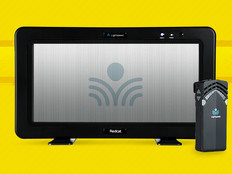Technology Means Survival For North Dakota School Districts
Nestled in a five-mile-wide valley, Eight Mile School District in Trenton, N.D., claims about 500 residents — many of them descendants of the Métis bloodline. The Native American population is on the rise here, which is an oddity since non-Native American schools in North Dakota are shrinking and being forced to do more with less. In remote towns such as ours, if it were not for technology, we would have almost none of the advantages that a larger school district has.
The district places a huge emphasis on technology — perhaps more than other, bigger schools in North Dakota. As technology in education progresses, it’s easy to be left behind. Eight Mile School is determined not just to keep up — but to go beyond.
The teacher, the textbook and the blackboard are tried-and-true educational tools. But their names have changed to the facilitator, the Internet and the digitized blackboard. These tools have taken a toehold here. We now have the ability to share student files over a local area network, digitize grades and evaluations for convenient statistical manipulation, use notebooks anywhere thanks to extended battery life, access the Internet wirelessly throughout the school and project Web pages on interactive white boards.
Thanks to the cultural diversity of the neighborhood, Trenton has been able to create and maintain an excellent academic community. What’s more, technology has become a great equalizer for many students. While some Native American communities are struggling to help their students succeed, many here at Eight Mile High School are at the top of their class.
The computer is fast becoming the pencil and paper in the lives of Trenton students.
Every student in eighth through 12th grades has a notebook computer. The oldest notebooks in the high school are less than three years old, and we hope to replace them at least every five years.
Trenton School also shares its abundant technology with other rural schools. We currently teach Spanish II to five schools simultaneously via an interactive video network (ITV) routed through the Internet. We also have an art teacher who presents instruction to neighboring schools through the Internet. Small schools depend on our convenient and reliable ITV services to share resources and access curricula they could otherwise not afford.
Wireless access to the Internet also eliminates distance for our own students and brings the world to our front door. Students can watch a demonstration at a New York City museum just as easily as they could travel to a town down the road.
Eight Mile School District doesn’t lay claim to any one great technology project but is proud of the fact that each teacher uses technology in the most practical ways. The Internet, the notebooks, the wireless access, ITV, computerized projectors, interactive white boards and other technologies are simply used as tools to teach the 3Rs.
Greg Svihl is principal at Eight Mile School in Trenton, N.D.
Who are the Métis?
The Métis Nation consists of descen-dants of marriages of the Woodland Cree, Ojibway, Saulteaux and Menominee Native American nations to French and British settlers. Métis communities expanded into northern U.S. states and throughout Canada as an outgrowth of the highly mobile fur trade network. The Métis Nation’s homeland is based on their traditional territory, including North Dakota and Montana. But today the majority of Métis live in Canada, where an estimated 350,000 to 400,000 Métis Nation citizens reside, according to a 2002 census.
Source: Métis National Council, http://www.metisnation.ca/
Trenton, N.D., is located about 200 miles northwest of Bismarck, near the Canadian border. About 100 residents live in the city, though the school boundaries include 500 residents. The median age is 33.8 years. Nearly three-quarters of Trenton’s population is Native American, 23.4 percent are white, and 3 percent represent other ethnic groups.






